Erin Robinson - Puzzle Bots interview
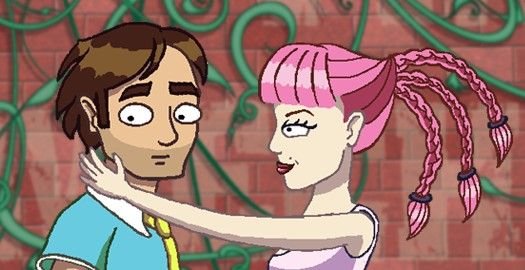
Although not yet a household name outside the independent game community, Erin Robinson is the artist and designer behind such acclaimed freeware games as Spooks, Nanobots and Little Girl in Underland. Now working with Dave Gilbert's Wadjet Eye Games on her first commercial game, Puzzle Bots, Erin took some time to speak with Adventure Gamers about her path to success and what we can expect from her in future.
Adventure Gamers: Thanks for talking with us during what’s probably a very busy time right now. Can you tell us a little background about yourself?
Erin Robinson: Hello! I'm 23 and entering my fifth year of making games. I'm originally from Toronto but I recently moved to the US of A. Last year I finished my degree in psychology, and I'm trying to put it to good use when I design my games. I started working as a full-time indie developer just over a year ago, when Dave Gilbert offered me a publishing deal. In the past year I've been lucky enough to speak at a few conferences, giving awkward speeches in such places as LA, San Francisco, Ottawa, and Toronto.
AG: Now that you’ve moved into commercial game development, what's your greatest ambition?
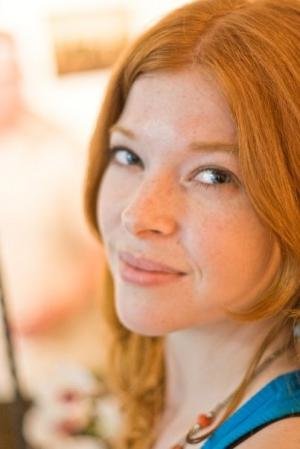 |
Erin Robinson |
Erin: I would love to run my own game company. And a big part of that would be to help other aspiring developers get into the game, so to speak. I have met dozens of talented, creative people who would like to get involved in independent games, but aren't sure where to begin. I would love to be able to say, "Here is a small project. Can you write a song/animate a character/program a GUI?" I certainly wouldn't have been able to get started without collaborative projects, and I'd like to carry that forward.
AG: How did you first get into adventures?
Erin: Back in the early days of PC gaming, they were my favourite kind of game. I played Myst with my brother shortly after we got our first computer with a CD ROM drive. I think I was about eight when I played it, and to this day I'm secretly proud that I figured out how to get to the Stoneship age "all by myself." Another favourite of mine was King's Quest VII, which to me felt like a Disney movie that I could play. And even though these games had very different ways of telling a story, they've both really stuck with me in terms of what you can do with the adventure medium.
AG: And when did you first get into creating your own games?
Erin: Since 2005. During my first year at university we had this incredible snowstorm that left drifts that were taller than I was. I started to get this idea for a game that took place in an abandoned university, where the snow had mysteriously never melted. The idea was that everyone had evacuated except for one girl, who was trying to survive by going through the old buildings and trying to discover what was causing the storms. Anyways, it ended up being way too ambitious for a first project, so I decided to try for something shorter in the meantime. And that's when I started on Spooks, my first adventure game.
AG: Any plans to revisit that original idea again?
Erin: Hmm. Maybe I could revamp the whole thing as a survival-horror shooter where you have to take down abominable snowmen. But, in the meantime, no.
AG: Where did the inspiration for Spooks come from?
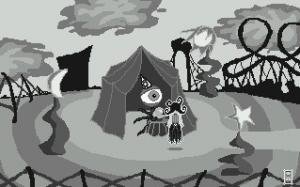
Erin: Well, at that point I had no experience with graphics or animation, and I wanted to keep it simple. So I decided I was going to make a game in gray scale because it'd be easier than trying to work out colour palettes. And a game about a little dead girl seemed to fit well in that. I wanted something to be in colour, just to give some life to the game and I think that's how the central idea of a dead girl rescuing a live goldfish came to be.
AG: Aww, I was hoping for some human interest emo story like "Well, I felt my own life was devoid of colour...". Its not autobiographical, then...
Erin: Not really, although I did have one reviewer suggest I made the main character dead because I was a brain-dead student at the time, which I thought was pretty funny.
AG: And there was some inkling about a Spooks sequel, but I guess that's on ice now.
Erin: For now, yeah. There's some talk of maybe porting Spooks somewhere but that's all I'll say about that for now.
AG: So, then you started on Nanobots.
Erin: Yep!
AG: That's a pretty ingenious little game. Was there anything that gave you the idea of robots with different skills?
Erin: I think I went with that because it seemed more natural than making one character with six different skills. Games like Monkey Island that had a whole bunch of verbs always seemed sort of overwhelming, so much so that trial and error became a good way to solve things. By making each verb associated with a different character, I hoped to make the puzzles a bit more approachable, and make the player less likely to give up. The game was still quite a challenge though, even for "hardcore" adventurers.
AG: I have to confess that I needed a walkthrough. I don't think I really qualify as "hardcore".
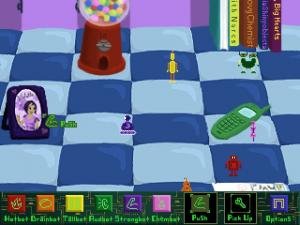 Erin: It's a tricky little game. I got the chance to watch a bunch of people playing it at Indiecade last week, and most of them needed my help to get started.
Erin: It's a tricky little game. I got the chance to watch a bunch of people playing it at Indiecade last week, and most of them needed my help to get started.
There was one group of three college guys who I didn't think would be interested in the game, but once they got a few things right, they couldn't stop playing. At one point they even refused to leave until they had figured out the first chemical puzzle, which was pretty rewarding to me.
AG: You've been invited to be at various events and on panels and have won prizes. What's it like being an "indie games celebrity"? Is it always rewarding?
Erin: Haha, I don't think this really counts as celebrity. I do enjoy going to conferences and meeting with new people, but the most rewarding part is knowing you're part of a bigger indie gaming community. Being around other creative people is a very recharging experience. And hearing how they're running their own businesses and making it work makes me think anything is possible.
AG: Other female game designers have written about the lack of "girls in gaming". What's your take on that?
Erin: Well, I think it's great fun, and I hope women who are even considering it will try to get involved. It's a very male-dominated sort of space at the moment, but I think that's changing. Especially in indie games.
AG: I guess that indie game creation really gives you complete freedom, does it?
Erin: You do get creative freedom, but you've got to balance that against what you think people will buy (if you're trying to support yourself, that is). It's certainly worthwhile just to make games that no one else is making.
AG: Do you think it’s hard for someone to support themselves in the current economy just on indie game creation?
Erin: Well, it's never easy to forge out on your own, but luckily Dave has been incredibly supportive from the very beginning. To me, it's worth taking in a bit less money to be able to have creative freedom. But I do think it's possible to really succeed in indie game development, even if it isn't easy.
Adventure Gamers: You first started working with Dave doing art for Blackwell Unbound, right?
Erin Robinson: Yep! I did the backgrounds and character sprites over the course of a summer. I helped out with project management on Convergence. And I drew the inventory and magic spell sprites for Emerald City Confidential. As you may have guessed, Dave is a pretty easy guy to work with.
AG: You also slipped in a side-project of Little Girl in Underland.
Erin: Yeah, that was a collaboration with Francisco "Magic Smiling Cat" Gonzales (author of the Ben Jordan series). I can't believe it all came together in a month, but I'm happy with how it all turned out. We ended up getting 4th place in a contest that had about 70 entries, so that was pretty exciting!
AG: And now you're working on Puzzle Bots. For any readers not familiar with its predecessor Nanobots, what's the story behind the new game?
Erin: Puzzle Bots is about five little robots who live in a robot factory. When their human creators aren't paying attention, they like to sneak out and have adventures. Each robot does one special thing: there's a robot that can pick things up, a robot that can push heavy things, a robot that can swim, etc. They have to work together to solve puzzles that they come across. And because they are so small, it usually means they're interacting with everyday objects on a massive scale. They also catch wind of a sinister plot, but they might be too small to do anything about it...
AG: Puzzle Bots' title sounds like it’s a more... puzzle-y sequel to Nanobots. Is that about right?
Erin: It's kind of a hybrid casual-adventure game. Rather than having one long, uninterrupted story, the game is broken down into levels. It helps narrow down the number of steps you have to take to complete a task, and hopefully keeps all the fun parts of puzzle-solving. Also, there are built-in hints. That's a must. And we're also throwing in a few bonus collectible items to hunt for.
AG: Can the "hardcore" adventurer turn the hints off if they prefer?
Erin: They can ignore the hints... It's a button you can push that will cause the robots to have a little pow-wow.
AG: When designing a game, is it hard to draw the line between accessible and challenging?
Erin: It is, yeah. Usually to decide which way to go, I ask myself which would be more fun.
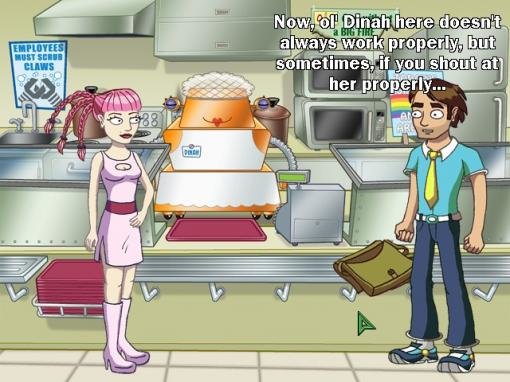
AG: How does Puzzle Bots compare in length/size to Nanobots?
Erin: Nanobots was practically a one-room game, whereas Puzzle Bots has 16 different levels. Puzzle Bots is much more player-friendly in terms of difficulty. When a new bot is introduced, the player has to take that bot through three tutorial rooms. The later levels should be a bit more of a challenge, but by then the player will have had plenty of practice with the individual robots. And then it's smooth adventurin'.
AG: What improvements would you say Puzzle Bots has made over your previous games?
Erin: Being able to hire artists and a musician has meant a huge jump in the quality of the game. And Janet Gilbert, one of our programmers, has had a great deal of experience in the casual games industry. She gives me pointers about making the game more intuitive and accessible. I have a lot of people watching my back when it comes to design and art decisions, which makes my job a lot more relaxing. Relatively speaking, of course.

AG: I've heard tell that there's "making out" in Puzzle Bots. What's the story there?
Erin: Well, see, early in the game the bots accidentally set up two of the humans, Zander and Astrid, on a date. Then they accidentally make that date more romantic. Then Astrid sort of misunderstands Zander's interest in her, and before you know it, there's some making out going on. And that is just the beginning of a very problematic love triangle.
AG: Are you enjoying working on a much larger game?
Erin: It's been so rewarding watching the game come together. At the moment, I've got four people contributing art or music assets to the game, and both Dave and his fiancee are helping with the coding. It's been a huge team effort, but the fact that everybody really believes in the project has made my job easy. In a lot of ways it doesn't seem to matter that we're all working remotely.
AG: When can we expect to see the fruits of your labours?
Erin: We're really hoping to have it out early 2010, knock on wood. If it looks like we should take a couple extra weeks to add polish, though, I wouldn't hesitate to do that.
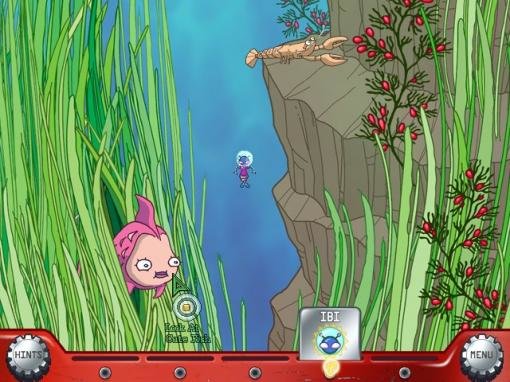
AG: Are there more projects in the pipeline after Puzzle Bots for your fans to look forward to?
Erin: I do believe so, but nothing I'm going to comment on yet.
AG: You've also got a few cartoons that you've drawn on your Lively Ivy website. Did they come before or after you started making games?
Erin: Those are all comics I did while I was in university. I started doing them about a year before getting into games. By a weird coincidence, my school was the only place in Canada with a weekly humour publication, so I got a lot of practice writing terrible jokes. This is a tradition I continue to this day.
All the human characters in Puzzle Bots are drawn and animated by me. Dave has some wonderful voice actors at his disposal, and the combination of the goofy voices and drawings makes the game seem very alive to me. I'm really happy with how it's turning out. My love of comics influences the way I write quite a bit. At the risk of giving away my methods, that's why the dialog in my games is very punchline-oriented.
AG: Are you still doing cartoons, or is it games all the way for now?
Erin: Just games for now, but I'd love to get back into comics someday.
AG: Thanks for taking the time to do this interview. Have you any final witty remark for our readers?
Erin: How cheesy can I get here?
AG: Well, it’s your interview...
Erin: Real adventurers never die. Unless they forget to save.
(You can't die in Puzzle Bots, btw.)













